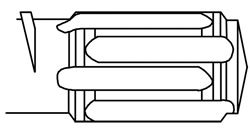Single-Screw Mixing 101
Almost all processes using a single screw require some degree of mixing, whether it’s just to homogenize regrind with virgin resin or to mix in some color concentrate.
Almost all processes using a single screw require some degree of mixing, whether it’s just to homogenize regrind with virgin resin or to mix in some color concentrate. Although there have been many presentations on mixing by experts over the years, processors often find it complicated to apply this information to their own requirements. Many processors also confuse poor melting with poor mixing. Most polymers and additives cannot be effectively mixed until everything that can be melted is melted. As a result, melting and mixing often must be dealt with in the same screw design, although the solutions are often not the same.
There are three kinds of mixing: dispersive, distributive, and extensional. We will deal here only with dispersive and distributive mixing, as extensional mixing occurs predominantly in twin-screw extruders. Dispersive mixing is like putting two materials to be mixed between two plates and rotating one of the plates. The shear stress developed in the polymer between the plates would be proportional to the distance between the plates and the speed at which the plate was rotated.
Distributive mixing is like putting the two materials in a bowl and stirring them with a spoon. The number and path of the spoon strokes would be proportional to the degree of mixing.
Screws inherently provide both dispersive and distributive mixing. Generally, the shallower the screw the more dispersive mixing occurs, and the more disruptions in the flow path the more distributive mixing occurs.
A worn screw actually makes an excellent mixer. As the polymer leakage over the flights increases with increasing barrel/screw clearance, both dispersive and distributive mixing increase significantly. Increased dispersive mixing occurs as the polymer and additives pass through the narrow gap between the screw flight and barrel, where the shear stress is very high. Distributive mixing occurs as the polymer leaking over the flights is continuously blended into the polymer in the adjacent channels. I have heard many times about a processor putting in a new or rebuilt screw and finding that mixing quality has been reduced. Naturally, this was blamed on whoever built or repaired the screw. Worn screws would be an easy solution to many mixing problems, but the downside is you get decreased output from them.
In order to maintain output and accomplish the required mixing, screw designers have created a wide variety of mixing devices. No one mixer fits all situations, so it is important to determine exactly what your overall process requirements are before selecting a mixer or even a combination of mixers.
Dispersive mixing applies force to the materials and thus requires drive energy that ends up in the polymer mix to help melt it and/or raise its temperature. Consequently, dispersive mixing assists or adds to the melting capacity of the screw. In addition, its tight clearances often function as a “dam,” restricting unmelted polymer from passing through until reduced in size or melted. Many screw designs would discharge unmelted polymer at almost all speeds without a dispersive mixer. The “Maddock” mixer is a very popular example of a mixer that is primarily dispersive, with lesser distributive characteristics.
Although distributive mixing also requires some drive power, it is generally small enough to have a very minor effect on the melt temperature. A “Saxton” style mixer is an example of a mixer that is mostly distributive with minor dispersive characteristics.
A mixer combining strong dispersive and distributive characteristics is called the “Egan” style mixer. All of the flights are undercut so there is a lot more dispersive and distributive mixing than with the Maddock mixing section.
The mixers mentioned here are only for illustration of the principles and are not necessarily the only recommended designs. Like many things in polymer processing, there is no single answer to the mixing issue, and you may want to consult someone knowledgeable about this subject. The objective here is to give you some background to help evaluate your situation.
About the Author
Jim Frankland is a mechanical engineer who has been involved in all types of extrusion processing for more than 40 years. He is now president of Frankland Plastics Consulting, LLC. Contact jim.frankland@comcast.net or (724) 651-9196.
Related Content
Back to Basics on Mold Venting (Part 2: Shape, Dimensions, Details)
Here’s how to get the most out of your stationary mold vents.
Read MoreWhere and How to Vent Injection Molds: Part 3
Questioning several “rules of thumb” about venting injection molds.
Read MoreWhy Shoulder Bolts Are Too Important to Ignore (Part 1)
These humble but essential fasteners used in injection molds are known by various names and used for a number of purposes.
Read MoreImproving Twin-Screw Compounding of Reinforced Polyolefins
Compounders face a number of processing challenges when incorporating a high loading of low-bulk-density mineral filler into polyolefins. Here are some possible solutions.
Read MoreRead Next
For PLASTICS' CEO Seaholm, NPE to Shine Light on Sustainability Successes
With advocacy, communication and sustainability as three main pillars, Seaholm leads a trade association to NPE that ‘is more active today than we have ever been.’
Read MoreLead the Conversation, Change the Conversation
Coverage of single-use plastics can be both misleading and demoralizing. Here are 10 tips for changing the perception of the plastics industry at your company and in your community.
Read MorePeople 4.0 – How to Get Buy-In from Your Staff for Industry 4.0 Systems
Implementing a production monitoring system as the foundation of a ‘smart factory’ is about integrating people with new technology as much as it is about integrating machines and computers. Here are tips from a company that has gone through the process.
Read More
.jpg;width=70;height=70;mode=crop)

















